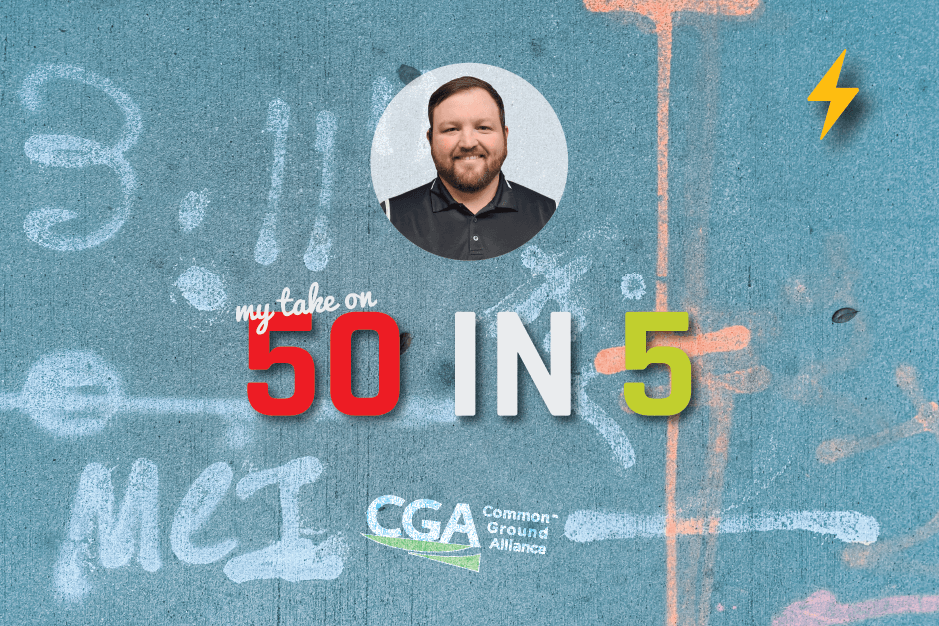
The CGA recently announced their industry industry challenge to stakeholders to cut damages in half by 2028. This initiative is being called “50 in 5” as it represents a reduction of damages to critical underground utilities by 50% in 5 years. 50 in 5 is a call to action focused on improving 3 areas which were originally identified in the CGA’s Next Practices Initiative. Those being:
1. Effective and consistent use of 811
2. Key excavator practices (potholing, maintaining clearance, etc.):
3. Accurate, timely utility locating
Individually these are important areas to tackle but together they add up to more than 76% of damages to buried infrastructure. (According to the CGA’s most recent DIRT Report) I think it’s terrific that the CGA is presenting this vision and setting the goal of reducing damages over the next 5 years in the most effective areas. With the CGA’s ever-increasing influence on the industry I think we need them to set lofty but achievable goals like this to help us all move forward. Using the data that we have from the DIRT report means that it’s easy to identify the root causes of damages in the industry and should be straightforward to address them.
However nothing in the damage prevention industry is ever that straightforward and there will be roadblocks on our way to reducing damages. The following are some of the disparate thoughts I’ve had surrounding this subject, many of which come from feedback by you guys working in the field everyday:
- The federal government is responsible for the infrastructure bill and increase in investment, but the state governments are who back the 811 Centers and I think we need some of the money and resources being diverted into improving what One Call Centers can do.
- Use of 811 isn’t an awareness problem it’s the reward/risk factor. Many contractors will run the risks if it means getting the job done because the rewards currently outweigh the risks of getting caught. We need greater education on the likelihood of damages and greater penalties to those rogue contractors. I think we also need to encourage contractors to be more vocal in the industry and invite them into decision making roles.
- Which leads me on to potholing which can escalate costs quickly to the contractor and many see as optional. We need to find ways to address this problem for example with compensation (as noted in CGA’s next practices). Plus I think we need clearer communication on tolerance zones - we could put it on the locate package, on the emails excavators receive etc.
- In addition I think there needs to be more coordination and standardization across 811 centers to encourage white lining and mapping. Mapping initiatives like NUAR and KLIC in Europe show the way and right now the CUIR group is working on something for North America - I think we can at least have more progress on this in the next 5 years and some pilot schemes. (Kind of like the one in Minnesota but in a more federally connected manner) Having the 811 centers on the same page regarding mapping and making it available to stakeholders would greatly reduce guesswork for excavators and make locators jobs easier!
- 5 years is a short time to reduce damages by 50% but it’s also a long time to stay focused on a big goal. I think we should have some smaller goals - these could come from the CGA or we could break it down by 811 areas or just individually at our own companies to help us stay focused and on track. Everything little action adds up, and I believe retains the 3 target areas and zooming in on effective metric movers could help us build momentum.
- None of these action items work if we don’t apply them to our own situation. Maybe your company is doing perfectly fine at using 811, potholing and locating isn’t a problem… well there’s still progress to be made! Look at the other damage causes in DIRT report and figure out where you’re falling short and start figuring out how to address those areas.
Sarah K. Magruder Lyle, president and CEO of CGA, cites the Bipartisan Infrastructure Law and the pace of current construction activity as the impetus, “to seriously examine how we can make the next dramatic reduction in annual damages and protect critical infrastructure.” And said that we’re at an, "inflection point as an industry,” which I very much agree with - now is the time!
Reducing damages by 50% in in 5 years is a lofty goal, but I think it’s achievable if we get organized and start acting as if that’s the most important part of our industry. The 3 areas that the CGA identified need to be tackled in a coordinated fashion with resources and stakeholders in unison, and I think we need to break them off into bitesize chunks that are attainable and measurable. I’ll leave you with the words of Josh Hinrichs, chair of CGA’s board and president of UtiliSource. “We must focus on taking damage prevention to the next level in order to keep our communities safe and connected to the utilities we depend on every day.”
Share this Post











